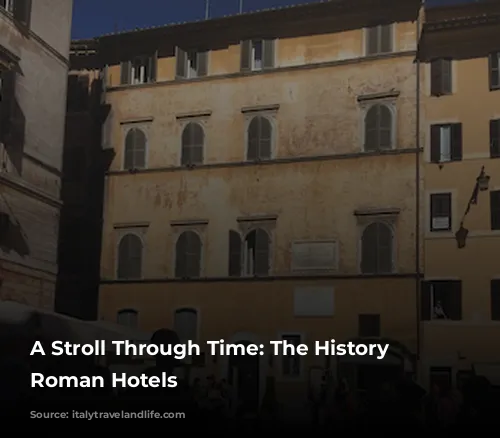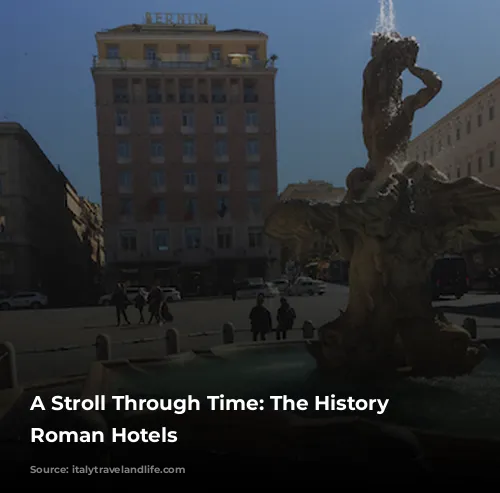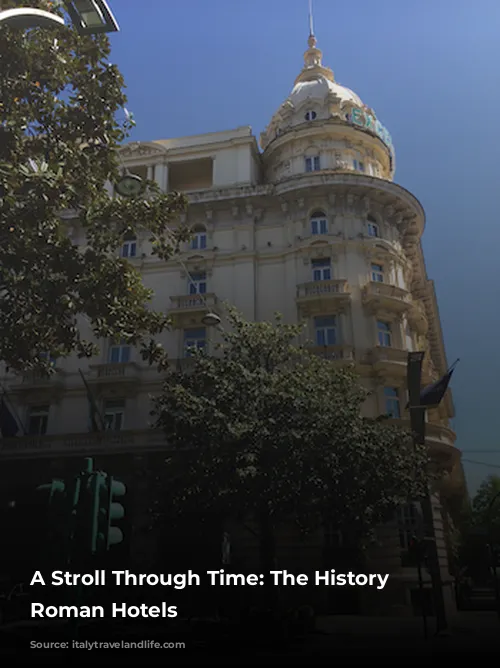Step back in time and explore the captivating history of Rome through its hotels. This journey takes you from medieval inns to grand palaces, tracing the evolution of hospitality in the Eternal City.
A Glimpse into Rome’s Ancient Inns
In the mid-19th century, a comprehensive survey of Roman hotels revealed a fascinating mix of establishments. Small inns, some with roots in medieval times, offered humble accommodations alongside the burgeoning number of larger hotels. The imposing Hotel de la Minerve, nestled near the Church of Santa Maria sopra Minerva, exemplified this trend. Initially a grand palazzo, it was transformed into a hotel in 1810 by a French hotelier, Joseph Sauve. Today, it stands tall, augmented with a couple of additional floors.
The Hotel del Sole: A Literary Haven
Just a short walk from the Grand Hotel de la Minerve (as it is now known), you’ll find a hidden gem—the Hotel del Sole. This unassuming townhouse, facing the Pantheon’s fountain, boasts a rich literary legacy. It was here, in 1513, that the renowned poet Ludovico Ariosto sought refuge. He had been invited by Pope Leo X for a dinner meeting, a much warmer welcome than he had received from his predecessor, Pope Julius II, who had attempted to have him assassinated.
A Tapestry of Notable Guests
The Hotel del Sole has played host to a diverse array of notable figures throughout its history. The Holy Roman Emperor Frederick III and the enigmatic Count Cagliostro, a magician, alchemist, and swindler, have graced its halls. After World War II, the hotel became a Roman sanctuary for renowned intellectuals Jean-Paul Sartre and Simone de Beauvoir.
A Hotel With a Rich Past
Records suggest that the hotel dates back to 1497, when it was known as the Ram. However, its origins likely predate this period. Over the centuries, ownership has changed hands, with the Alberini family, a Turkish family, and the Benedictine convent of Santa Maria in Campo Marzio all leaving their mark. In 1890, the hotel played host to Pietro Mascagni, who celebrated the debut of his groundbreaking opera, Cavalleria rusticana, within its walls. This landmark performance revolutionized the landscape of Italian opera.
From Baroque Squares to Elegant Palaces: The Rise of Grand Hotels
Rome’s architectural splendor provided the perfect backdrop for the emergence of luxurious hotels. The Piazza del Popolo, a masterpiece of baroque design, was the stage for the creation of several iconic hotels.
The Hotel de Russie: A British Haven
The Hotel de Russie, constructed by the renowned urban planner and architect Giuseppe Valadier, stands proudly opposite Santa Maria in Montesanto. Valadier had envisioned the entire piazza, but between 1816 and 1818, he built a grand palazzo for Count Giovanni Torlonia, the Vatican’s financial administrator. The palazzo offered breathtaking views of the piazza until the second half of the 19th century when new buildings obstructed the vista.
From Private Residence to Public Inn
Despite the palazzo’s elegance, Count Torlonia decided to convert it into a hotel. This was a shrewd decision, considering that Piazza del Popolo served as Rome’s main northern entrance, attracting a constant stream of pilgrims and tourists. Among them was the celebrated British artist William Turner, who captured the hotel’s construction in a sketch in 1819.
A Haven for Writers and Artists
A guide published in 1833 described the hotel as an “excellent Inn which furnishes 150 beds”. While the bedrooms may have been relatively small, the hotel’s modern-day incarnation, with two extra floors and garden wings, offers 121 rooms. The hotel has attracted a diverse array of notable guests, including Charles Dickens, who stayed in 1853, and Wilkie Collins, who complained of Rome’s damp climate in 1862.
A Hotel With a Changing Name
After the unification of Italy in 1871, the hotel was renamed Albergo dei Rei, a patriotic gesture. However, its growing popularity among Russian nobility led to a hybrid name—Hôtel de Russie et des Iles Britanniques.
The Hotel d’Inghilterra: A Royal Welcome
Continuing our journey towards the Spanish Steps, we reach the Hotel d’Inghilterra. In 1845, recognizing Rome’s need for more hotels, Prince Giovanni Torlonia transformed his family’s guest wing into an auberge across from Palazzo Núñez-Torlonia. To attract English guests, it was named Albergo d’Inghilterra, a name still proudly displayed above the entrance.
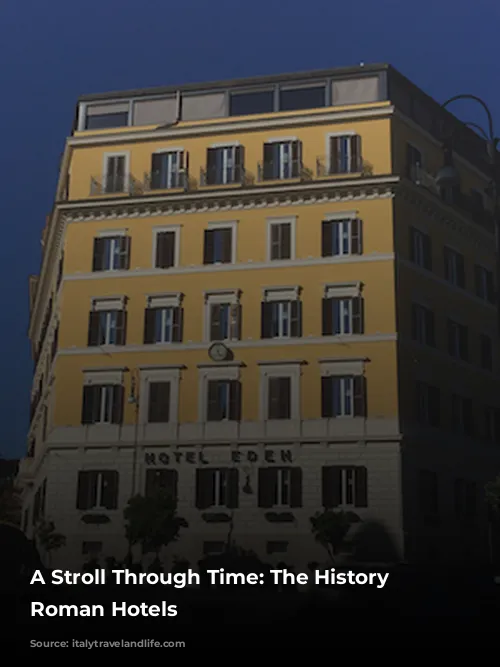
The Gilded Age of Roman Hotels: Opulence and Innovation
The late 19th century witnessed a surge in hotel construction in Rome. The city’s expanding tourism industry, fueled by the allure of history and culture, spurred the creation of grand hotels that embraced both tradition and modernity.
The Hotel Hassler: A Family Affair
The Spanish Steps offer a breathtaking view of the city. At the top, stands the Hotel Hassler, established in 1889 by Francesco Nistelweck and his wife, a member of the Hassler family.
The Hotel Eden: A Panoramic Oasis
Just a short distance away, nestled on the Pincian Hill, is the Hotel Eden. This elegant hotel was transformed from a villa owned by Prince Piombino Boncompagni Ludovisi. The hotel’s 63 rooms offered, and continue to offer, stunning panoramic views of the city.
The Hotel Regina: A Royal Legacy
Heading down Via Lodovisi, we arrive at Via Vittorio Veneto, where the Hotel Regina stands tall. Built between 1892 and 1894 by Cavaliere Giovanni Barbiani, it was designed by Giulio Podesti, a prominent architect of 19th-century Rome.
A Royal Residence
The hotel’s neoclassical architecture and its strategic location near the royal palace made it a favorite among the elite. In 1910, Queen Margherita di Savoia, who had to temporarily vacate the royal palace, chose the Hotel Regina as her temporary residence for several months. The hotel was subsequently renamed in her honor, a lasting tribute to its royal connection.
The Hotel Excelsior: A Cinematic Icon
Across Via Vittorio Veneto, the Hotel Excelsior stands as a testament to the grandeur of the 20th century. Opened in 1906, it was hailed as the “most Parisian hotel in Rome” due to its elegant Jugendstil cupola and triple-arched entrance adorned with carvings of African, Asian, European, and American caryatids.
A Grand Setting for Hollywood
Inside, the Excelsior offers a dazzling display of glass, gold, and natural light streaming through its large windows. This cinematic landmark has hosted numerous stars and filmmakers, including the cast and crew of Ben-Hur (1957) and La Dolce Vita (1960).
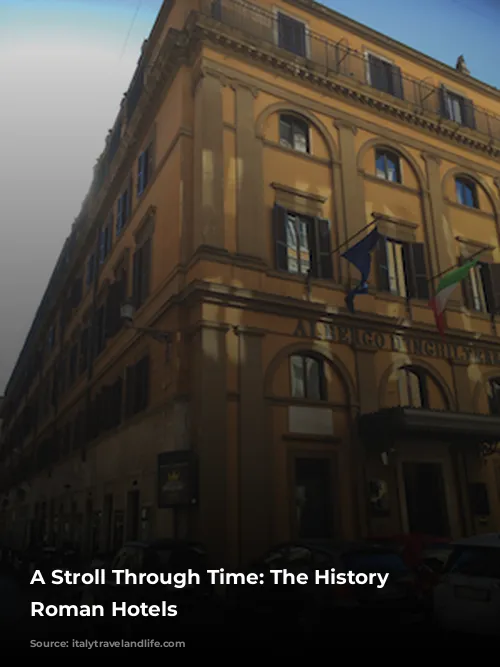
From Modernity to Modernism: Rome’s Hotel Evolution Continues
The 20th century saw the rise of modern hotels, reflecting the changing tastes and desires of travelers. Roman hotels embraced the Art Deco aesthetic and streamlined designs, while maintaining their commitment to exceptional hospitality.
The Hotel Bristol: A Fascist-Era Makeover
Located on Piazza Barberini, the Hotel Bristol underwent a complete transformation between 1939 and 1942, embracing the Rationalist style favored during the Fascist era. Originally opened in 1874, the hotel was housed in an old palazzo and had once welcomed illustrious guests such as Emperor Pedro II of Brazil, Tsar Nicholas of Russia, and wealthy American families like the Rockefellers and Vanderbilts.
The Hotel Rome Cavalieri: A “Hollywood on the Tiber”
Beyond the Aurelian Walls and the Vatican, on Monte Mario, stands the magnificent Rome Cavalieri, a resort hotel that epitomizes luxury and sophistication. Inaugurated in 1963 by Conrad Hilton himself, it offers stunning views of the city and a “Hollywood on the Tiber” ambiance.
Modern Boutique Hotels: A New Wave of Elegance
In the 21st century, Rome’s hotel scene has evolved to encompass a range of modern boutique hotels. These stylish establishments often occupy historic buildings, offering a blend of contemporary design and old-world charm. Portrait Roma, a collection of individual suites above Salvatore Ferragamo in Via Condotti, and JK Place Roma, housed in a 17th-century building that once served as Rome’s School of Architecture, are prime examples.
A Circle Complete: From Humble Beginnings to Modern Luxury
Our journey through Rome’s hotel history brings us back to the city’s heart. JK Place Roma, a mere eight-minute walk from Albergo De Sole, where we began our exploration 600 years earlier, symbolizes the continuous evolution of hospitality in the Eternal City. As Rome embraces the future, its hotels continue to reflect its rich history and enduring allure.
